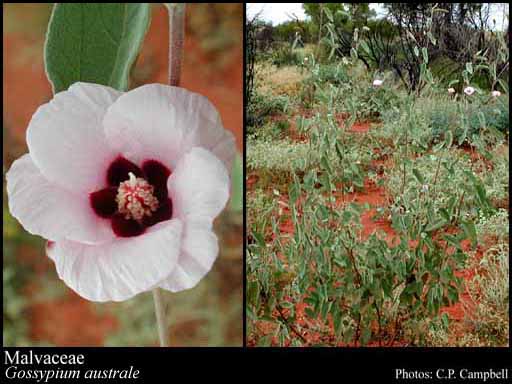- Reference
- Gen.Pl. [Jussieu] 271 (1789)
- Name Status
- Current

Scientific Description
Common name. Mallow Family.
Habit and leaf form. Herbs and shrubs, or trees (a few). Mesophytic, or xerophytic. Leaves alternate; spiral; petiolate; non-sheathing; simple. Leaf blades dissected (usually), or entire; when dissected, palmately lobed; palmately veined; cross-venulate. Leaves usually with stipules; without a persistent basal meristem. Leaf anatomy. Hydathodes present (occasionally), or absent. Complex hairs commonly present. Complex hairs stellate (very commonly), or peltate. Stem anatomy. Nodes tri-lacunar, or penta-lacunar, or multilacunar. Secondary thickening developing from a conventional cambial ring.
Reproductive type, pollination. Fertile flowers hermaphrodite, or functionally male, or functionally female, or hermaphrodite, functionally male, and functionally female. Unisexual flowers present, or absent. Plants hermaphrodite (usually), or dioecious (rarely), or polygamomonoecious (rarely). Entomophilous.
Inflorescence and flower features. Flowers solitary, or aggregated in ‘inflorescences’; in cymes. The terminal inflorescence unit cymose. Inflorescences compound cymose, composed of cincinni. Flowers small to large; regular to somewhat irregular. The floral asymmetry involving the perianth (the petals often asymmetrical), or involving the perianth and involving the androecium. Flowers cyclic. Free hypanthium absent. Perianth with distinct calyx and corolla; 10; 2 -whorled; isomerous. Calyx 5; 1 -whorled; polysepalous, or gamosepalous (basally); valvate; regular. Epicalyx present (often, representing aggregated bracteoles or stipules?), or absent. Corolla 5; 1 -whorled; polypetalous (but often seeming gamopetalous at first sight, through association with the androecial tube); contorted, or imbricate; often asymmetrical. Fertile stamens present, or absent (rarely, when flower female). Androecial members definite in number, or indefinite in number. Androecium (5–)15–100 (i.e. usually ‘many’). Androecial members branched (usually, involving the inner whorl of stamens, the androecium originating from relatively few trunk bundles); when many (i.e. usually), maturing centrifugally; adnate (to the petals); coherent (the into a tube); 1 - adelphous (the tube attached to the petals); 1 -whorled (usually, the outer whorl being supposedly absent). Androecium exclusively of fertile stamens (or rather, half-stamens, each having only a half anther). Stamens (5–)15–100; isomerous with the perianth to polystemonous. Anthers dehiscing via longitudinal slits; introrse; unilocular; bisporangiate. Pollen shed as single grains. Fertile gynoecium present, or absent (rarely, when flower male). Gynoecium (1–)5(–100) carpelled (i.e. sometimes ‘many’). The pistil 1–100 celled (to ‘many’). Gynoecium syncarpous; synovarious to synstylovarious; superior. Ovary unilocular, or plurilocular; (1–)5(–100) locular (occasionally many-locular, and the Malopeae with horizontal transverse divisions of the carpels into 1-ovuled portions). Locules each divided horizontally into one-ovulate locelli (Malopeae), or not horizontally divided. Styles (1–)5(–20); free to partially joined; apical. Stigmas dry type; papillate, or non-papillate; Group II type. Placentation axile. Ovules 1–50 per locule (i.e. to ‘many’); ascending (usually), or pendulous (sometimes); with ventral raphe to with dorsal raphe; anatropous to campylotropous.
Fruit and seed features. Fruit non-fleshy (usually), or fleshy; dehiscent, or indehiscent, or a schizocarp. Mericarps when schizocarpic, comprising follicles, or comprising nutlets (‘cocci’, rarely). Fruit a capsule (usually), or a berry (Malvaviscus). Capsules loculicidal. Seeds endospermic. Endosperm oily. Seeds conspicuously hairy, or not conspicuously hairy. Cotyledons 2. Embryo chlorophyllous (7/9), or achlorophyllous (2/2); usually curved. Micropyle zigzag. Seedling. Germination phanerocotylar.
Physiology, biochemistry. Aluminium accumulation not found. Photosynthetic pathway: C3.
Geography, cytology, number of species. World distribution: cosmopolitan tropical and temperate, also Iceland. X = 6–17(+), 20(+). 1000 species.
Economic uses, etc. Gossypium seed supplies commercial cotton, pulp and oil. ‘Rosella fruit’ (Jamaica sorrel) is the fleshy calyx and bracts of Hibiscus sabdariffa, while ‘ochra’ (‘okra’) is the young fruits of Hibiscus esculentus. Some pot-herbs (Malva parviflora), and many ornamentals.
Keys
Key to the Malvaceae of Western Australia
C. Hollister, K.R. Thiele
Western Australian Genera and Families of Flowering Plants — an interactive key
T.D. Macfarlane, L. Watson, N.G. Marchant